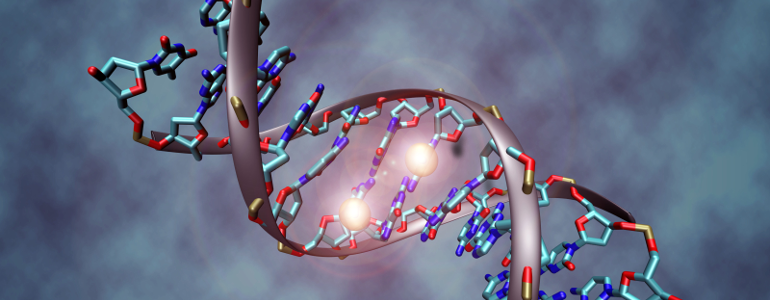CRISPR – the Breakthrough of the Year.
2015 was the year for gene-editing to shine, especially thanks to CRISPR-Cas9. Voted Breakthrough of the Year by the Science journal panel of scientists, few techniques have made such a quick and controversial impact in the last decades as CRISPR. Even though it was already nominated for Breakthrough of the Year in 2012 and 2013, 2015 was the year that CRISPR revealed its full potential for clinical applications.
CRISPR stands for Clustered Regularly-Interspaced Short Palindromic Repeats, which are DNA segments repetitions, interspaced with “spacer” DNA derived from viral infections. Clustered repeats were found as early as 1987, even though their function was not known at the time. It was only in 2007 that scientists from the Danish company Danisco understood that bacteria use these DNA sequences to fight viral infections and that the CRISPR system was part of bacteria’s immune system. Another team, led by the duo Doudna and Charpentier, has already been focusing on the CRISPR system that relied on protein Cas9. The principles behind this mechanism are relatively simple. [expand] Following viral infection, bacteria produce RNA that forms a complex with the Cas9 protein. When the produced RNA binds the matching DNA from the virus, the Cas9 protein cuts the viral DNA, disabling the virus from infecting the bacteria. Doudna and Charpentier found out that they could use this system not only to target viral DNA, but potentially DNA from every organism, therefore creating one of the most powerful tools of gene editing. By engineering the RNA to target a specific gene in a specific cell, the Cas9 protein will allow to cut and replace any target gene. [/expand] The simplicity of CRISPR makes it one of the most useful and revolutionary tools for researchers since the invention of PCR, as John Schimenti, a geneticist at Cornell University in New York, claims.
[youtube http://www.youtube.com/watch?v=2pp17E4E-O8]
Gene-editing techniques are not new. Since the 70s, scientists have been editing, adding and deleting genes in some organisms. Nonetheless, no other tool has allowed them to specifically determine where to insert the desired genes or control where the deletions occur. This targeting precision, along with the fact that it is easy to use, cheap and applicable to every organism, is what makes CRISPR such an attractive tool. For three years ago the majority of the mechanisms behind CRISPR systems have been understood. Since then scientists have announced a considerable number of exciting possible clinical applications. For instance, only in the last six months of 2015, researchers were able to activate the expression of genes associated with human diseases; to incorporate a gene that kills the malaria parasite into a population of mosquitos, the main carriers of the disease; and to improve the muscle function of mouse models with Duchenne muscular dystrophy.
TALEN – from leukemia remission to micro pigs pets
But CRISPR is not the only gene-editing technique that received major attention in 2015; TALEN enzymes have also allowed researchers to experiment with new therapies. The most exciting one was the achievement of complete remission in Layla, a one-year-old girl with an extremely aggressive type of leukemia. Researchers extracted immune cells from a healthy donor and, using TALEN enzymes, they were able to deactivate genes that would otherwise allow Layla’s immune cells to attack the donor cells. This was the first successful usage of gene-editing therapies in immune cells, with considerable exciting results. Layla is now cancer free and doing well.
Another thrilling announcement, but with more controversial results, was made by a Chinese company, Beijing Genomics Institute. BGI created, using the TALEN gene-editing technique, micro pigs to be sold as pets. Even though the company claims that the profits from the micro pigs will be used for future scientific research, several voices have been raised against the manipulation of such animals, especially after the company’s statement that they might create pigs with different patterns and colors.
Genetic manipulation of embryos – where to draw the line?
The fast pace at which gene-editing techniques are entering laboratories calls for a discussion on the ethical concerns that such techniques bring. This discussion is more necessary than ever, since Chinese scientists announced that they are already using CRISPR techniques in human embryos. Jennifer Doudna said she was ‘astounded at how quickly labs around the world had adopted the technology’. Now that it seems inevitable that researchers will apply CRISPR in human eggs, sperm and embryos to make inheritable changes in humans, Doudna calls for a ‘global pause in any clinical application of the CRISPR technology in human embryos, to give us time to really consider all of the various implications of doing so’.
These concerns were shared by the nearly 500 scientists that attended the International Summit on Human Gene Editing, last December. In the final statement, scientists claim that it ‘would be irresponsible to proceed with any clinical use of germline editing unless and until the relevant safety and efficacy issues have been resolved (…) and there is broad societal consensus about the appropriateness of the proposed application’.
Thus, 2015 was also a remarkable year for science because it showed us that scientists do not want to repeat past mistakes, by leaving the ethical implications of their work on someone else’s hands. It also seems clear that gene-editing will have a bigger impact on our lives, but not without careful scrutiny and societal discussion. Let us hope that 2016 brings the fulfillment of these promises.
References:
LA Times – Why CRISPR-Cas9 is being hailed as the scientific “Breakthrough of the Year”
TEDtalk – We can now edit our DNA. But let’s do it wisely.
Doudna J (2015). Genome-editing revolution: My whirlwind year with CRISPR. Nature, 528 (7583), 469-71 PMID: 26701037
Perez-Pinera, P., Kocak, D., Vockley, C., Adler, A., Kabadi, A., Polstein, L., Thakore, P., Glass, K., Ousterout, D., Leong, K., Guilak, F., Crawford, G., Reddy, T., & Gersbach, C. (2013). RNA-guided gene activation by CRISPR-Cas9–based transcription factors Nature Methods, 10 (10), 973-976 DOI: 10.1038/nmeth.2600






I liked the article and wished it was longer. I want to know more about what the possibilities are. If we go wild with this stuff, will we have intelligence boosting gene therapy, genius kids, disease free lives?
Thank you JE Moody. I would say that we are already going wild with this, mainly because we are going in the oposite direction of what is being reccommended (last december we had scientists saying that it would be irresponsible to use clinical applications in embryos, then one month later the UK is giving permission for a lab to edit viable human embryos). Not saying we shouldn’t explore the possibilities, just saying that this is a something completely revolutionary that we are yet not prepared do handle.
To answer your question, two things should be consider: We can alter the embryonic line, and then we can perhaps have genius and beautiful kids (I don’t think we know enough about the all the genes involved in making such magnificent creatures, though…), but also to “program” them to be born disease-free, which seems a cool thing to do.
We can also alter the genome in traits that will not pass to the next generation. On this, I would say we have made some real progresses, especially with the leukemic remission or the malaria parasite that I mention in the article.
Sorry for the long post. I recomend you to check this article in your blog, from 2014: http://goo.gl/axp3nt.
Also, the TED Talk from Doudna, one of the most important scientists working on the field: https://goo.gl/f6aBJX
What an interesting post! Gene manipulation is nothing new, and if studied and tested carefully can help improve the lives of so many humans! Testing on animals is the fist important step. Humans share brains similar to monkeys and rats and humans and animals can show a lot of the same behavioral characteristics. Animals’ structures and cells are also similar to humans. Humans and monkeys have almost the same genetic make up. Although sometimes considered unethical, gene manipulation testing should be done on animals extensively before applied to humans, so that the procedures are safe and effective. The pigs mentioned in this article would make great research testers. I do, however, think that manipulating the shape and color of a pig is silly and useless. I think gene manipulation research should only be used to benefit the person’s health. In the case of the little girl with leukemia, this is a wonderful case where gene manipulation can save someone’s life and improve their health. Intelligence boosting and manipulation of genes to determine eye color and hair color in a child unborn, while neat and interesting, shouldn’t be a top priority and is thought to be unethical by many. I believe gene manipulation should only be done to improve lives and benefit ones health, such as gene manipulation to help cure a disease or stop complications from a disease. Gene manipulation for looks and appearance changes is interesting, but the possibilities here are endless and will most likely be expensive. I believe that more time, money, and effort should be put forth in studying gene manipulation for those whose overall health will benefit.